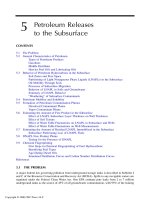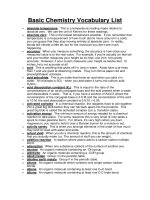Experiment 1 environmental chemistry PFD
Bạn đang xem bản rút gọn của tài liệu. Xem và tải ngay bản đầy đủ của tài liệu tại đây (878.86 KB, 5 trang )
CIVL375: Water and Wastewater Technology
Experiment 1: Dispersion Coefficient of a Plug Flow Reactor
Introduction
The design of reactors is a very important aspect in the field of water and wastewater
treatment. Reactors could be batch, completely stirred, plug-flow, packed bed, or
fluidized packed bed. Plug flow reactors are classified as ideal plug flow (no
dispersion), or dispersed plug flow. In practical, the former is rarely found although
sometimes assumed to ease the calculations especially if little mixing occurs during
the flow.
In the dispersed plug flow reactors, any input stimuli (e.g. a tracer) injected at the inlet
will exit from outlet after dispersion. Figure 1 shows how an injected pulse of a
chemical will appear in the effluent (output) of the reactor. When dispersion is zero
(σ2=0), the chemical will appear suddenly at the outlet. When dispersion is large
(large σ2), the chemical spreads and appears at different levels as time elapsed.
Fig. 1: Plug flow reactor and effluent concentration showing different levels of
dispersion.
The dispersion coefficient (D) of a plug flow reactor can be determined
experimentally using moment analysis of an injected conservative tracer. This is done
by determining the effluent concentration versus time after injecting the tracer. From
such data one can determine the followings:
t =
The centroid (actual retention time)
t C
σ2 = ∑ i i −t2
∑σC2 i
2
σθ = 2
t
2
The variance
∑ tiCi
∑ Ci
The normalized variance
The normalized variance is related to the dispersion number by
σ θ2 = 2
D
D
− 2( ) 2 (1 − e −uL / D )
uL
uL
Thus, the dispersion number (D/uL) is determined by trial and error. The dispersion
coefficient can then be determined given that L and u (=Q/A) are known from the
applied experimental conditions.
Objective
The objective of this experiment is to determine the dispersion coefficient (D) of a
plug flow reactor in the laboratory.
Procedure
A reactor shown in Fig. 2 will be used to conduct the experiment on and determine its
dispersion coefficient.
NaCl
water
Tap
water
Inlet
Gate
L
H
Outlet
Fig. 2: Plug flow reactor prototype.
1. Determine the dimensions of the reactor (L, W, and H).
2. Use a pump that gives 100 ml/min flow. Determine the flow accurately by a
graduated cylinder and a stop watch (Q=V/t).
3. Prepare 6 liters of 5000 mg/l NaCl solution using tap water.
4. Measure the TDS of the prepared solution.
5. Measure the TDS of the tap water alone.
6. Fill the reactor with Tap water with the inlet gate closed.
7. Fill the inlet tank with the NaCl solution with the inlet gate closed.
8. Start injecting the NaCl solution, open the gate and the outlet valve at the same
time. Also, start the stop watch.
9. Take a sample from the effluent every 5-10 minutes and measure TDS.
10. Stop injecting solution after 30 minutes by closing outlet valve, stopping the
pump, and place the gate back. Also stop the watch
11. Empty the inlet tank from the NaCl solution and fill with tap water.
12. Attach the pump to the tap water line and continue pumping with tap water, open
the gate, and open the outlet valve, continue the stop watch.
13. Continue sampling the outlet water for TDS every 5-10 minutes till the outlet
concentration reaches that of tap water.
14. Correct TDS readings by subtracting the value of TDS for tap water from the
readings.
Requirements:
1. Fill out the provided experiment data sheet and carry out the required calculations.
2. If you are requested to submit a report of this experiment then your report should
contain (a) an introduction that ends with the objective (b) methodology including
sample identification (c) results and discussion (d) conclusion (e) references and (f) an
appendix that contains the filled data sheet.
Experiment 1 Data Sheet
Dispersion Coefficient of a Plug Flow Reactor
Name
ID
Experimental conditions
Date the experiment was conducted
TDS of NaCl solution (mg/l)
TDS of tap water (mg/l)
Reactor length (L) in cm
Reactor width (W) in cm
Reactor depth (H) in cm
Flow rate (Q) in ml/min
Injection duration (min)
Effluent concentration (mg/l) versus time (min) after injection
Effluent
Corrected
Effluent
Time
Time
TDS
TDS
TDS
Corrected
TDS
Required Calculations:
1. Plot the effluent TDS versus time.
2. Determine the experimental retention time and compare with the theoretical value.
3. Determine the dispersion coefficient of the reactor









